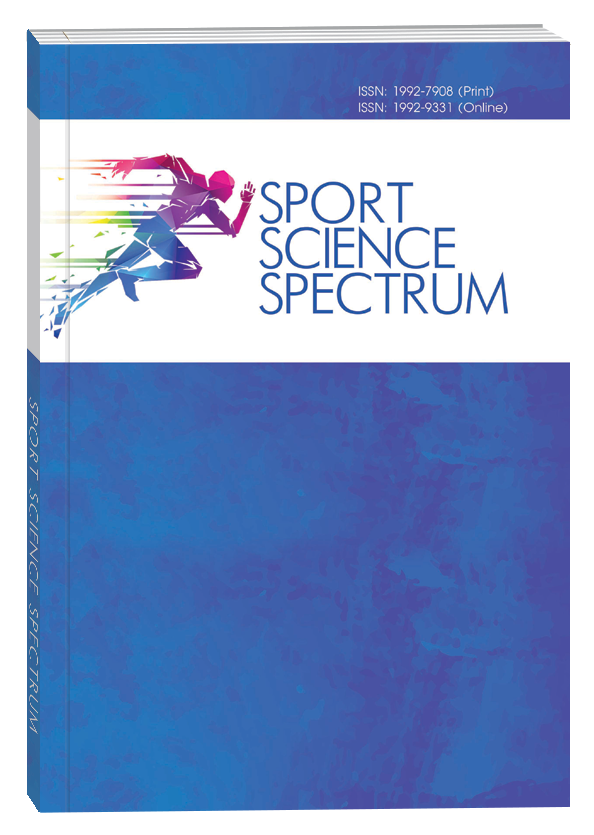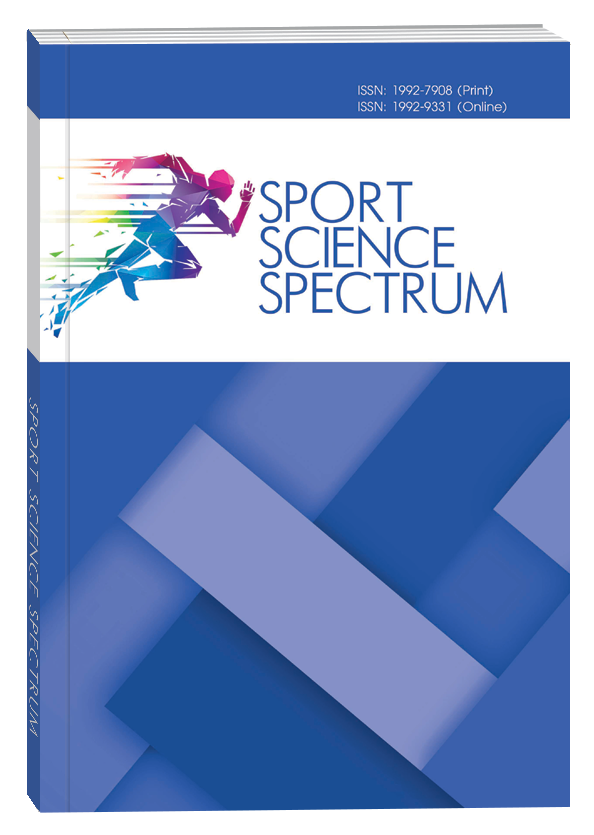PROGRAM FOR CORRECTION OF PHYSICAL CONDITION AND PSYCHO-EMOTIONAL STATE OF INTERNALLY DISPLACED WOMEN THROUGH HEALTH-ENHANCING RECREATIONAL PHYSICAL ACTIVITY
DOI:
https://doi.org/10.32782/spectrum/2025-1-2Keywords:
physical activity, internally displaced women, adulthood, program, physical condition, psycho-emotional state, quality of lifeAbstract
The article is focused on the development of the structure and content of the program based on the use of the means of health-enhancing recreational physical activity for the correction of physical condition and psycho-emotional state in internally displaced adult women, as well as on the evaluation of its effectiveness. The objective of the study was to substantiate and develop a program for the correction of indicators of physical condition and psycho-emotional state in middle aged women from among internally displaced persons by means of health-enhancing recreational physical activity aimed at improving the quality of life, social adaptation, and reducing anxiety. Materials and methods. The study involved 96 middle-aged women.The SF-36 Health survey questionnaire was used to assess the quality of life, and the depressive state was assessed using the Beck scale. Structural- functional analysis was used to build the structure and content of the stages of the program for the correction of physical condition and emotional state in internally displaced adult women. The program effectiveness was evaluated in the course of a transformative pedagogical experiment. Results. The program for correction of physical condition and psycho-emotional state in internally displaced adult women was based on science-based approaches to the use of physical activity to improve mental and physical health, designed for 24 weeks duration, and included three stages (preparatory, main and control-corrective). Smart objectives were proposed for each stage, according to which the forms, means, and criteria of effectiveness were defined. The impact was evaluated by the level of depression in the women studied. After completing the program, 73.2 % of the participants reported no depressive symptoms, indicating a significant improvement in their psycho-emotional state. The overall level of physical quality of life increased by 12 %, to 47.7 points; general health improved by 14 %, to 48.3 points; and physical activity increased by 14 %, to 48.2 points. Conclusions. For this group of people who have experienced stressful and traumatic events, the program is an effective tool for improving their quality of life.
References
1. Андрєєва О., Дутчак М., Благій О. Теоретичні засади оздоровчо-рекреаційної рухової активності різних груп населення. Теорія і методика фізичного виховання і спорту. 2020. Т. 2. С. 59–66. DOI: 10.32652/tmfvs.2020.2.59–66.
2. Андрєєва О., Гакман А., Волосюк А. Аналіз рівнів тривожності внутрішньо переміщених жінок зрілого віку. Вісник Прикарпатського університету. Серія: Фізична культура. 2024. Вип. 43. С. 3–9.
3. Андрєєва О., Гакман А., Волосюк А. Аналіз якості життя й рівнів депресії внутрішньо переміщених жінок зрілого віку. Sport Science Spectrum. 2024. Вип. 1. С. 56–61.
4. Андрєєва О., Гакман А., Волосюк А. Взаємозв’язок рухової активності та компонентів якості життя внутрішньо переміщених жінок першого періоду зрілого віку. Вісник Кам’янець-Подільського національного університету імені Івана Огієнка. Фізичне виховання, спорт і здоров’я людини. 2024. Вип. 29, № 3. С. 119–125. DOI: 10.32626/2309-8082.2024-29(3).119-125.
5. Мазіна Н. E. Соціально-економічна адаптація внутрішньо переміщених осіб: підходи до виміру. Вісник Маріупольського державного університету. Серія: Філософія, культурологія, соціологія. 2016. № 12. С. 131–138.
6. Міжнародна організація з міграції ООН. (2024). URL: https://ukraine.iom.int/uk/dani-ta-resursy (дата звернення: 20.02.2025).
7. Наконечна А. В. Показники фізичного стану жінок другого зрілого віку, які займаються за системою Дж. Пілатеса. Фізичне виховання, спорт і культура здоров’я у сучасному суспільстві. 2012. № 3. С. 233–236.
8. Песоцька Ю. Соціальна реабілітація та соціальна адаптація внутрішньо переміщених осіб. Social work and education. 2022. № 9(1). С. 232–238.
9. Синиця Т. О. Корекція фізичного стану жінок першого зрілого віку засобами оздоровчої аеробіки та ментального фітнесу : автореф. дис. … канд. наук з фіз. виховання та спорту, Харківська держ. акад. фіз. культури]. 2019. ENUPPIR. URL: http://reposit.pntu.edu.ua/handle/PoltNTU/7319 (дата звернення: 20.02.2025).
10. Степанова І., Плошинська А., Черевко С. Особливості психофізичного стану студентів, які постраждали під час проведення антитерористичної операції. Спортивний вісник Придніпров’я. 2022. № 1. С. 140–150.
11. Шишкіна О. М., Бейгул О. І., Муллагільдіна А. Я. Позитивні зміни у психоемоційному стані жінок при застосуванні фітнес-аеробіки. Вісник Чернігівського національного педагогічного університету. Серія: Педагогічні науки. Фізичне виховання та спорт. 2015. № 129(3). С. 345–348.
12. Andrieieva, O., Byshevets, N., Kashuba, V., Pasichniak, L., Lazakovych, Y. Application of mental fitness tools in the prevention of stress-associated conditions of female students of higher education establishments. Fizicna Reabilitacia ta Rekreacijno-Ozdorovci Tehnologii. 2024. 9(3). P. 98–112.
13. Andrieieva, O., Nahorna, A., Yarmak, O., Yerakova, L., Kyrychenko, V., Drozdovska, S., Petrachkov, O., & Buznik, A. Identification of Informative Physical Condition Indicators for Self-Training Exercise Programs Design for Middle-Aged Overweight and Obese Women. Sport Mont. 2021. 19(S2). P. 75–81. DOI: 10.26773/smj.210913.
14. Byshevets, N., Andrieieva, O., Dutchak, M., Shynkaruk, O., Dmytriv, R., Zakharina, I., Serhiienko, K., & Hres, M. (2024). The influence of physical activity on stress-associated conditions in higher education students. Physical Education Theory and Methodology. 24(2). P. 245–253. DOI: 10.17309/tmfv.2024.2.08.
15. Drozdovska, S., Andrieieva, O., Yarmak, O., & Blagii, O. (2020). Personalization of health-promoting fitness programs for young women based on genetic factors. Journal of Physical Education and Sport. 20. P. 331–337. DOI: 10.7752/jpes.2020.s1046.
16. Kashuba, V., Andrieieva, O., Hakman, A. & Zukow, W. (2021). Impact of aquafitness training on physical condition of early adulthood women. Teorìâ ta Metodika Fìzičnogo Vihovannâ. 21(2). P. 152–157. DOI: 10.17309/tmfv.2021.2.08.
17. Kashuba V., Tomilina Y., Byshevets N. et al. (2020). Impact of Pilates on the Intensity of Pain in the Spine of Women of the First Mature age. Teorìâ ta Metodika Fìzičnogo Vihovannâ. 20(1). P. 12–17.
18. Krutsevich, T., Trachuk, S., Ivanik, O., Panhelova, N., Brychuk, M., & Kedrych, H. (2021). Assessment of a Healthy Lifestyle and Quality of Life of Men and Women in Modern Society Based on SF 36. Teorìâ ta Metodika Fìzičnogo Vihovannâ. 21(3). P. 211–218. DOI: 10.17309/tmfv.2021.3.04.
19. Lee I. M., Shiroma E. J., Lobelo F., et al. Effect of physical inactivity on major non-communicable diseases worldwide. The Lancet. (2019, 380(9838). P. 219–229.
20. Lins L., Carvalho F. M. SF-36 total score as a single measure of health-related quality of life: Scoping review. SAGE Open Medicine. 2016. 4. P. 1–12. DOI: 10.1177/2050312116671725.
21. Smith P. J., Blumenthal J. A., Hoffman B. M., et al. Aerobic exercise and neurocognitive performance. Psychosomatic Medicine. 2020, 72(3). P. 239–252.
22. Williams, K. L., Smith, L., & Johnson, R. (2018). Social integration through recreational activities. Journal of Community Health. 43(4). P. 812–820.
23. World Health Organization. Mental health in emergencies. 2022. URL: https://www.who.int/news-room/fact-sheets/detail/mental-health-in-emergen-cies (дата звернення: 20.02.2025).





